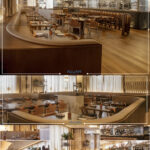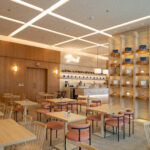Introduction:
Designing spaces that cater to individuals across different age groups is a multifaceted endeavor. From toddlers to seniors, each demographic has unique needs and preferences when it comes to their living or working environment. In this article, we’ll delve into the 10 Innovative Strategies for Fitouts that Appeal to All Generations, exploring innovative strategies and expert insights to create inclusive and appealing interior fitout for everyone.
Understanding Generational Diversity in Design
Creating spaces that resonate with people from various generations requires a deep understanding of their characteristics, preferences, and lifestyle trends. With this 10 Innovative Strategies for Fitouts that Appeal to All Generations you will be able to understand each generation, from Baby Boomers to Gen Z, brings its own set of values and expectations to the table.
Tailoring Spaces for Baby Boomers
Baby Boomers, born between 1946 and 1964, value comfort, functionality, and familiarity in their living spaces. Design elements such as ergonomic furniture, ample lighting, and accessibility features can enhance their comfort and convenience.
Appealing to Gen X’s Desire for Versatility
Gen X individuals, born between 1965 and 1980, appreciate spaces that offer versatility and adaptability. Open floor plans, multifunctional furniture, and integrated technology solutions resonate well with this demographic.
Understanding Millennial Preferences
Millennials, born between 1981 and 1996, prioritize experiences, sustainability, and connectivity in their living and working environments. Designing eco-friendly spaces with flexible work areas and collaborative zones can cater to their preferences.
Meeting the Needs of Gen Z
Gen Z, born between 1997 and 2012, is characterized by its digital nativism, individuality, and desire for authenticity. Incorporating technology seamlessly into the design, providing personalized spaces, and fostering creativity are essential for engaging this demographic.
The Role of Accessibility and Inclusivity
Creating spaces that accommodate individuals of all abilities is paramount in inclusive design. Accessibility features such as ramps, wide doorways, and tactile signage ensure that everyone can navigate and use the space comfortably.
Incorporating Biophilic Design Elements
Biophilic design, which integrates natural elements into built environments, has been shown to improve well-being, productivity, and creativity. Incorporating elements such as natural light, indoor plants, and views of nature can enhance the appeal of spaces across generations.
Maximizing Comfort and Ergonomics
Comfort and ergonomics play a crucial role in designing spaces that cater to all age groups. Ergonomic furniture, adjustable lighting, and climate control systems contribute to a comfortable and conducive environment for people of all ages.
Harnessing Technology for Enhanced Experiences
Integrating smart technology solutions can elevate the functionality and user experience of spaces. From smart lighting and thermostats to voice-controlled assistants, technology can streamline daily tasks and enhance accessibility for everyone.
Designing for Multigenerational Living
Multigenerational living arrangements, where multiple generations coexist in the same household, present unique design challenges and opportunities. Flexible layouts, private retreats, and shared communal spaces can promote harmony and connection among family members of all ages.
Overcoming Common Design Challenges
Designing spaces for all age groups requires addressing common challenges such as limited square footage, budget constraints, and diverse user preferences. Creative solutions, thoughtful planning, and collaboration with design professionals can help overcome these obstacles effectively.
Ensuring Safety and Security
Safety and security are paramount considerations in designing spaces for all age groups. Implementing measures such as slip-resistant flooring, childproofing features, and emergency exits enhances the safety and peace of mind of occupants across generations.
Addressing Environmental Sustainability
Sustainability is increasingly becoming a focal point in design, with emphasis on energy efficiency, resource conservation, and environmental stewardship. Incorporating sustainable materials, passive design strategies, and renewable energy sources contributes to a healthier planet for current and future generations.
Promoting Social Connection and Well-Being
Spaces that foster social connection and well-being have a positive impact on individuals of all ages. Designing communal areas, green spaces, and recreational amenities encourages interaction, engagement, and overall happiness among occupants.
Enhancing Emotional Resonance and Identity
Creating spaces that evoke positive emotions and reflect the identity of the occupants is key to their long-term satisfaction and enjoyment. Personalized touches, meaningful artwork, and cultural references contribute to a sense of belonging and attachment to the space.
Leveraging Data and Feedback for Continuous Improvement
Gathering feedback and data on space utilization, user satisfaction, and evolving needs is essential for continuous improvement. Utilizing analytics tools, conducting surveys, and engaging stakeholders in the design process enables iterative enhancements that optimize the space for all age groups.
Conclusion:
Designing spaces that cater to all age groups requires a thoughtful blend of creativity, empathy, and expertise. By understanding 10 Innovative Strategies for Fitouts that Appeal to All Generations, that is the diverse needs and preferences of different generations, embracing inclusive design principles, and leveraging innovative strategies, designers and architects can create spaces that are not only functional and aesthetically pleasing but also enriching and inclusive for everyone.
Frequently Asked Questions (FAQs)
Q: How can I make my space more accessible to individuals with disabilities?
A: Making your space more accessible to individuals with disabilities involves various considerations. Start by ensuring that there are ramps or elevators for wheelchair access, wide doorways to accommodate mobility aids, and grab bars in bathrooms. Additionally, incorporate visual and auditory cues for those with sensory impairments, such as braille signage and audible alarms. It’s also essential to consult accessibility guidelines and regulations to ensure compliance and create a welcoming environment for all.
Q: What are some cost-effective ways to incorporate biophilic design elements into my space?
A: Incorporating biophilic design elements doesn’t have to break the bank. Start by introducing indoor plants, which not only enhance aesthetics but also improve air quality and well-being. Consider maximizing natural light by strategically placing windows and using reflective surfaces to amplify daylight. Incorporating natural materials like wood, stone, or bamboo can also bring a sense of nature indoors without significant cost. Remember, even small touches like nature-inspired artwork or textures can contribute to a biophilic environment.
Q: Are there any regulations or guidelines I need to consider when designing for multigenerational living?
A: When designing for multigenerational living, it’s essential to consider relevant regulations and guidelines to ensure the safety, comfort, and legal compliance of the space. Depending on your location, there may be building codes, zoning laws, or accessibility standards that dictate certain requirements for multigenerational dwellings. Additionally, consult with design professionals who have experience in this area to address specific needs and navigate any regulatory requirements effectively.
Q: How can I ensure the safety of children and seniors in my space?
A: Ensuring the safety of children and seniors in your space requires implementing appropriate measures tailored to their needs. For children, focus on childproofing areas with safety gates, cabinet locks, and rounded furniture edges. Keep hazardous items out of reach and secure heavy furniture to prevent tipping accidents. For seniors, address mobility challenges by installing handrails, non-slip flooring, and adequate lighting in hallways and staircases. Consider incorporating features like walk-in showers and lever-style door handles for ease of use. Regular maintenance and safety inspections are also crucial for maintaining a safe environment for everyone.
Q: What are the benefits of incorporating sustainable design principles into my project?
A: Incorporating sustainable design principles into your project offers numerous benefits beyond environmental stewardship. Sustainable practices can lead to cost savings through energy efficiency, reduced water consumption, and lower maintenance requirements over time. Additionally, sustainable materials and construction methods contribute to healthier indoor environments by minimizing exposure to toxins and pollutants. From a broader perspective, embracing sustainability demonstrates social responsibility, enhances brand reputation, and future-proofs your investment against evolving regulations and consumer preferences.
Q: How can I create a sense of community and belonging in shared spaces?
A: Creating a sense of community and belonging in shared spaces requires fostering opportunities for interaction, collaboration, and mutual respect among occupants. Start by designing communal areas that encourage gathering and socializing, such as common rooms, outdoor seating areas, or shared kitchens. Organize events, workshops, or activities that bring people together and promote connections. Incorporate elements of inclusivity and diversity in the design to ensure that everyone feels welcome and represented. Encourage communication and feedback from residents to foster a sense of ownership and pride in the community space.






